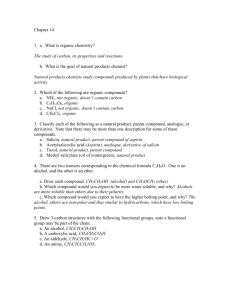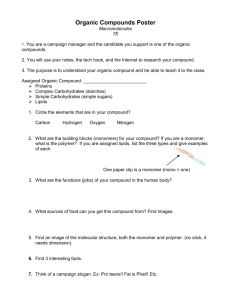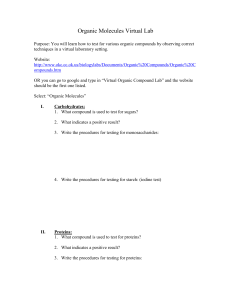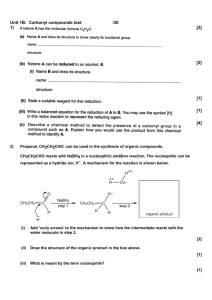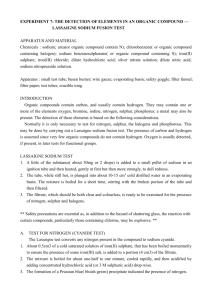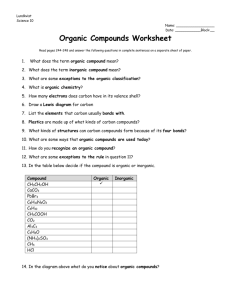Sodium nitroprusside test
advertisement
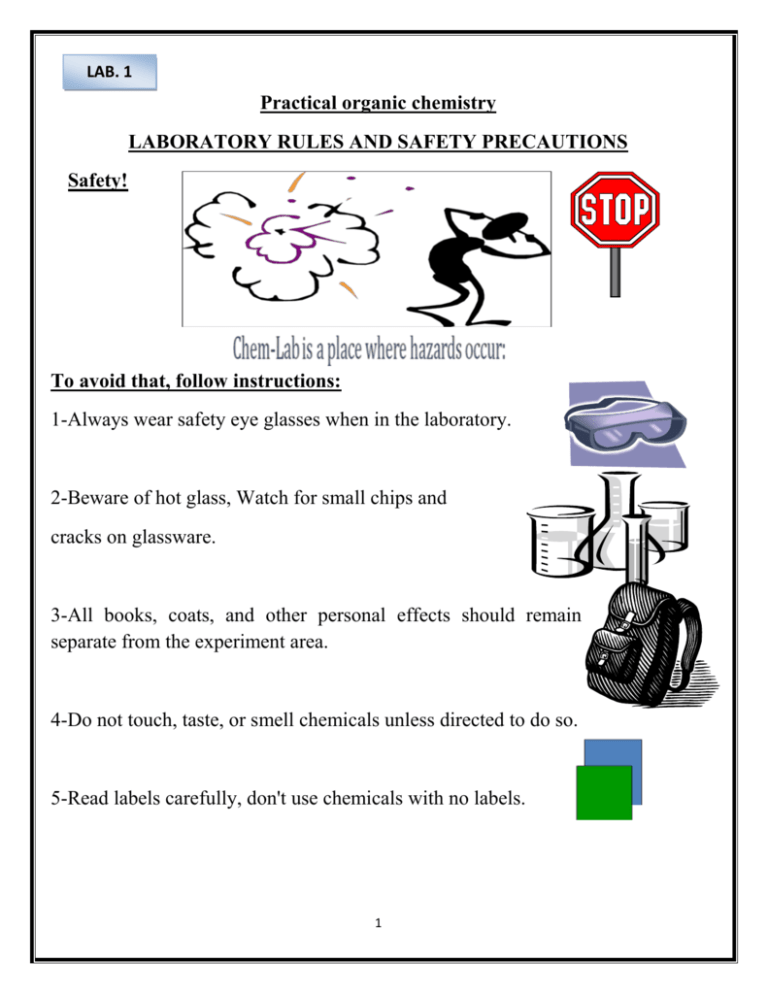
LAB. 1 Practical organic chemistry LABORATORY RULES AND SAFETY PRECAUTIONS Safety! To avoid that, follow instructions: 1-Always wear safety eye glasses when in the laboratory. 2-Beware of hot glass, Watch for small chips and cracks on glassware. 3-All books, coats, and other personal effects should remain separate from the experiment area. 4-Do not touch, taste, or smell chemicals unless directed to do so. 5-Read labels carefully, don't use chemicals with no labels. 1 6-pour acids slowly and carefully, Never add water to acids. 7-Wear gloves when handling caustic chemicals. 8-When inserting glass tubing or thermometers into rubber stoppers, always lubricate both the glass tubing and the hole with glycerin. 9- To determine the odor of a compound, bring the stopper of the bottle cautiously towards the nose, do not inhale. 10- Never, heat an organic liquid directly over a flame except under a condenser. When refluxing a liquid, be sure that the condenser is tightly fitted. If a temperature below 95 oC is sufficient, use a steam bath rather than a burner. COMMON LABORATORY GLASS WARE AND EQUIPMENT Beaker Glass rod Funnels 2 Conical Separation Funnel Test Tube Holder Bunsen Burner Spatula Test tubes RackRound Volumetric Flask Bottomed Flask Graduated Cylinder Water Bath Hot Plate Identification of Organic compounds Physical character : • odour . • Color. • Condition. • Solubility and miscibility. 3 Balance Physical Properties: 1-Condition: Solid: A- Crystalline it has a definite shape may be : Needles, Prisms, Plates, Microcrystalline B- Powder may be Fine or Coarse C-Amorphous (has no definite shape) Solid-Crystalline- prisms Solid-Crystalline- needles Solid-Crystalline- microcrystals Solid – crystalline-plates Solid- crystalline- pill Solid – powder- (coarse or fine) 4 Liquid: A- Mobile (such as : methanol, ethanol) B- Viscous (such as lactic acid, glycerol) How you can write the condition? Condition: solid, crystalline, needles Condition: solid, crystalline, microcrystal Condition: solid, powder, fine Condition: solid, powder, coarse Condition: liquid, (mobile or viscous) 2-Color: Note and describe the color of the sample weather its liquid or solid. Why are some compounds colored? The colour is due to the presence of Chromophore group (causes extended NO conjugation) 2 Examples of chromophoric groups : NO2, COOH Benzene colourless Some of expected colors: Color Brown Pink Colorless turns brown due to air oxidation Colorless turns to yellow 5 Nitrobenzene Yellow colour Expected Substance Higher aromatic amines Naphthols Phenols, aniline, aminophenols Anthracene ,cinnamic acid 3-odour : if no odor odorless odour Bitter almond Expected Substance Benzaldehyde, nitrobenzene Mice like odour Pleasant sweety odour Vinegar like odour Fishy odour Pungent(irritant odour) Stable like odour Apple like odour Phenolic odour acetamide Esters-Chloroform Acetic acid Aniline Formaldhyde, lower acids P-toluidine Ethyl acetate Many phenols 4-solubility/miscibility: First you need to note the following: Solubility is for solids and we say soluble in. Miscibility is for liquids and we say miscible with. Solubility/Miscibility in (with) H2O: If a solid (liquid) is soluble (miscible) in (with) H2O then you need to determine whether it's acidic, basic or neutral this can be achieved through the use of litmus paper. When a blue litmus paper turns red then the compound is acidic When a red litmus paper turns blue then the compound is basic When the two litmus papers don't change in color then the compound is neutral 6 Solubility/miscibility in (with) H2O: miscible immiscible heavier immiscible lighter PURIFICATION OF SOLID ORGANIC COMPOUNDS Crystallization is : The process in which a solid substance separates from saturated solution as crystals. It is a technique which used to purify solid compounds, based on solubility and depends on: 1) Dissolving organic compounds (solutes) in hot liquids (solvents). 2) Filtration to remove impurities. 3) Cooling the hot solution to precipitate the organic compounds in crystal form. Types of solvents: Polar Solvent: Water, Methanol, Ethanol, Dioxan and Acetic acid. Non-Polar Solvent: benzene, Chloroform, n-Hexane and Dichloromethane. Recrystallization used to purify solids based on their different solubilities. 7 Recrystallization Steps: 1- Add a small quantity of appropriate solvent to an impure solid. 2- Apply heat to dissolve the solid. 3- Cool the solution to crystallize the product. 4- Use vacuum filtration to isolate and dry the purified solid. Ex. : Benzoic acid and Anthracene. Sublimation is : " The transition of a substance from the solid phase to the gas phase without passing through an intermediate liquid phase ". solid↔ vapor Ex.: Carbon dioxide, Iodine and Naphthalene. PURIFICATION OF LIQUID ORGANIC COMPOUNDS Distillation: - Distillation is the process of heating a liquid until it boils, capturing and cooling the resultant hot vapors, and collecting the condensed vapors. -Distillation is used for both identification and purification of organic compounds . 8 Types of Distillation : 1- Simple distillation: Purification of organic compounds from a non volatile impurities eg, (solid material). Simple distillation is designed to evaporate a volatile liquid from a solution of non-volatile substances; the vapor is then condensed in the water condenser and collected in the receiver. Fig. Simple distillation 2-Fractional Distillation: Mixtures of liquids whose boiling points are similar (separated by less than 70°C) cannot be separated by a single simple distillation. In these situations, a fractional distillation is used. 9 Fig. Fractional Distillation 3-Steam Distillation: Distillation of 2-immiscible liquids, this technique can be used for purification of high boiling liquids which decompose near their boiling points and these liquids are immiscible with water. Fig. Steam Distillation 10 4- Vacuum Distillation it is used to distill compounds that have a high boiling point or any compound which might undergo decomposition on heating at atmospheric pressure.The vacuum is provided either by a water aspirator or by a mechanical pump. Fig. Vacuum Distillation DETERMINATION OF PHYSICAL PROPERTIES FOR ORGANIC COMPOUNDS 1- Melting Points The temperature at which the solid phase is in equilibrium with the liquid phase for the given substanc , or the temperature at which the solid and liquid have the same vapour pressure. ( solid ↔ liquid ). 11 Mixed melting point Mixed melting points can be used in the following manner to determine whether two compounds are the same or different even they have similar melting points. Assuming that a given organic (A) melts sharply at 120 C, and benzoic acid (compound B) also has melting point at 120 C. Is compound (A) benzoic acid or different compound? If compound (A) is benzoic acid, then a mixed melting point of (A) and (B) will melt sharply at 120 C, i.e. the same as each individual compound alone. If , on the other hand , compound(A)is not benzoic acid, then the melting point of a mixture of (A) and (B) will be lowered and the melting range will be broadened. Since they are different compounds, each behaves as an impurity in the other. Fig. Melting point apparatus 12 2- Boiling Point The boiling point is the temperature at which the vapor pressure of the liquid phase of a compound equals the external pressure acting on the surface of the liquid.The external pressure is usually the atmospheric pressure. EXTRACTION WITH SOLVENTS Extraction : Separation and isolation of organic substances from the mixtures , it can be subdivided into : 1- Extraction of Solids: e.g. perfume essence from flowers by using solvents ( H2O, CHCL3 ) 2-Extraction of solutions : Technique used for isolation dissolved substances by shaking its solution with immiscible solvent in a separating funnel. On standing, the two immiscible phases (usually organic and aqueous) from two separate layer (upper and lower) that can be separated by a means of a separating funnel. Fig. separating funnel 13 CHROMATOGRAPHY 1- Thin Layer Chromatography – TLC is a simple, quick, and inexpensive procedure that gives quick answer to how many components are in a mixture. Fig. Thin Layer Chromatography 2- Column Chromatography: A purification technique used to isolates desired compounds from a mixture. *The stationary phase, a solid adsorbent, is placed in a vertical glass (usually) column and the mobile phase, a liquid, is added to the top and flows down through the column (by either gravity or external pressure). Fig. Column Chromatography 14 3- Gas Chromatography (GC): In gas chromatography the stationary phase is a high-boiling liquid and the mobile phase is an inert gas. *GC is used as an analytical tool to find out how many components are in a mixture. It can also be used to separate small amounts of material. Experimental ( 1) • Objective : Crystallization of Benzoic acid • Glassware: 2 conical flask , funnel , beaker, glass rod , stand , wire gauze, clamp .filter paper. • Chemicals : Benzoic acid , distilled water • Procedure : 1- Place 2gm of Benzoic acid in a 100ml conical flask 2- Heat 50ml of distilled water to boiling 3- Add the water to the benzoic acid until it dissolve completely using glass rod 4- Prepare a fluted filter paper and short –stem funnel , place it in a suitable conical flask and start to filtrate the hot solution rapidly . 5- Leave the filtrate to cool at room temperature 6- Filter the cold solution and collect the pure crystals. 15 Experimental ( 2) Objective : Separating a two-liquid component Glass ware : separating funnel, 2 conical flask, stand, wire gauze, clamp holder, filter paper. Chemicals: Chloroform, water. Procedure 1- Place 50ml of water and 50ml of chloroform in a separating funnel 2- Shake it well 3- Draw off the lower aqueous layer into a flask and repeat extraction of the lower phase 4- Draw off the other layer into another flask. 16 LAB. 2 The qualitative analysis of an organic compound The qualitative analysis of an organic compound involves the detection of all the elements present in it. Carbon and hydrogen are generally present in all organic compounds. Other elements which may be present in organic compounds are oxygen, nitrogen, sulphur, halogens, phosphorus, etc. Detection of Carbon and Hydrogen Carbon and hydrogen are detected by heating the organic compound with cupric oxide (CuO) strongly, where carbon is oxidized to carbon dioxide and hydrogen to water. Carbon dioxide is tested by lime water test, whereas water is tested by anhydrous copper sulphate test. Fig: Detection of carbon and hydrogen in an organic compound 2 17 Procedure 1- The given organic compound is mixed with dry copper oxide (CuO) and heated in a hard glass tube. 2- The products of the reaction are passed over (white) anhydrous copper sulphate and then bubbled through lime water. 3- If copper sulphate turns blue due to the formation of CuSO 4.5H2O (by water vapor) then the compound contains hydrogen. 4- If lime water is turned milky by CO2, then the compound contains carbon. Detection of nitrogen, sulphur and halogens Nitrogen, sulphur and halogens in any organic compound are detected by 'Lassaigne's test'. Lassaigne's test In this reaction we use sodium metal, which fused with the organic compound (C, N, S or X) to convert these elements into water soluble sodium salts. Caution * While using the sodium metal, following precautions should be taken into account: 1. Do not touch the sodium metal with your fingers, always use forceps to handle it. 18 2. Unreacted sodium metal should be carefully decomposed by adding small amount of ethyl alcohol into it. 3. Sodium metal reacts strongly with water, according to the following reaction 2Na(s) + 2H2O → 2NaOH (aq) + H2(g) Hydrogen gas (H2) released reacts strongly with oxygen in the air and make strong explosion. Apparatus required: Beaker, conical flask, funnel, test tubes, ignition tubes, capillary tubes, glass rod, test tube holder, spatula. Chemicals required: Organic compound whose extra element is to be determined, sodium metal, ferrous sulphate, lead acetate sodium nitroprusside, ferric chloride solution, silver nitrate, aq. NaOH, dil. Sulphuric acid, dil. Nitric acid, dil. Hydrochloric acid, conc. Nitric acid Procedure 1- Place 25-30 mg of fresh sodium metal into a dry Pyrex test tube (make sure that the test tube is undamaged). 2- Add approximately 10 mg of the (anhydrous) compound to be analyzed. Let the mixture rest for a few minutes. 3- Heat the test tube over a small flame, just enough to melt the sodium. Then heat more strongly so that the test tube becomes glowing red. 4-When all of the sodium has reacted, add 67 mL of water, heat the mixture until it boils and filter it. 19 5-The filtrate possibly contains sodium cyanide (originates from the elements of the sample), sulfide and halogens as a alkaline solution. Use the filtrate in the following tests: Determination of nitrogen 1-To 1 mL of filtrate , add a few drops of iron(II)sulfate (ferrous sulfate) solution. 2- Boil the mixture (to oxidize a part of the Fe2+ions to Fe3+ions by oxygen in air). 3- Acidify the solution by adding 2 M sulfuric acid, a blue green colour or blue precipitate (prussian blue, Fe4[Fe(CN)6]3) confirms the presence of cyanide ions. . Determination of sulphur The presence of sulphur in any organic compound is detected by using the filtrate as follows: 20 Lead acetate test 1- A small portion of sodium extract is acidified with acetic acid and lead acetate solution is added to it. 2- A black precipitate of lead sulphide indicates the presence of sulphur. Sodium nitroprusside test 1- Add one drop of a fresh, aqueous solution of sodium nitroprusside Na2[Fe(CN)5NO] to about 1 mL of the filtrate. 2- A pink or purple colour verifies the presence of sulfide ion. Test for nitrogen and sulphur present together 1-Take 1-2 ml of sodium extract in the test tube and acidify it with dilute hydrochloric acid. 2- Add 2-3 drops of ferric chloride solution. A blood red colour indicates the presence of nitrogen and sulphur together. Na + C + N + S From organic compound → NaCNS Sodium thiocyanate 21 3 NaCNS + → Fe+3 Fe(CNS)3 Ferric thiocyanate (blood red) Determination of halogens: Silver Nitrate Test (a) When nitrogen and / or sulphur are absent 1-Take 1-2 ml of sodium extract in test tube and acidify it with dilute nitric acid. 2- Add silver nitrate solution (0.5ml). -A white precipitate soluble in Ammonium hydroxide indicates the presence of chlorine. -A pale yellow precipitate soluble in excess of Ammonium hydroxide solution indicates the presence of bromine. -A yellow precipitate insoluble in Ammonium hydroxide indicates the presence of iodine. (b) When nitrogen and / or sulphur are present 1-Take 1 ml of filtrate in test tube and acidify it with conc. nitric acid (23ml). 2- Boil the mixture to reduce the original volume to half to get rid of HCN and /or H2S. And now perform the silver nitrate test. 22 University of Hail Faculty of Science Chemistry Department 2nd Year Manual Laboratory Practical Organic Chemistry II CHEM 271 23

